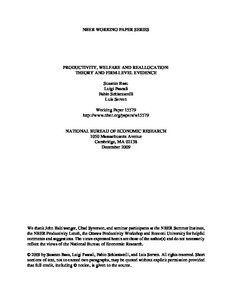Productivity, welfare and reallocation: theory and firm-level evidence
"We prove that the change in welfare of a representative consumer is summarized by the current and expected future values of the standard Solow productivity residual. The equivalence holds if the representative household maximizes utility while taking prices parametrically. This result justifie...
| Main Authors: | , , , , |
|---|---|
| Institution: | ETUI-European Trade Union Institute |
| Format: | TEXT |
| Language: | English |
| Published: |
Cambridge, MA
2009
NBER |
| Subjects: | |
| Online Access: | https://www.labourline.org/KENTIKA-19178153124919963359-Productivity,-welfare-and-real.htm |
| Summary: | "We prove that the change in welfare of a representative consumer is summarized by the current and expected future values of the standard Solow productivity residual. The equivalence holds if the representative household maximizes utility while taking prices parametrically. This result justifies TFP as the right summary measure of welfare (even in situations where it does not properly measure technology) and makes it possible to calculate the contributions of disaggregated units (industries or firms) to aggregate welfare using readily available TFP data. Based on this finding, we compute firm and industry contributions to welfare for a set of European OECD countries (Belgium, France, Great Britain, Italy, Spain), using industry-level (EU-KLEMS) and firm-level (Amadeus) data. After adding further assumptions about technology and market structure (firms minimize costs and face common factor prices), we show that welfare change can be decomposed into three components that reflect respectively technical change, aggregate distortions and allocative efficiency. Using the appropriate firm-level data, we assess the importance of each of these components as sources of welfare improvement in the same set of European countries." |
|---|---|
| Physical Description: | 48 p. Digital |

